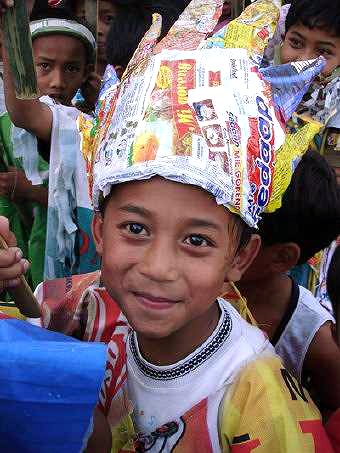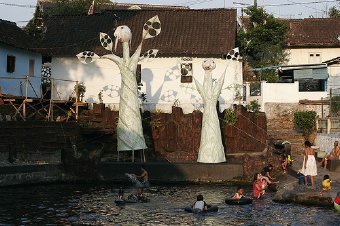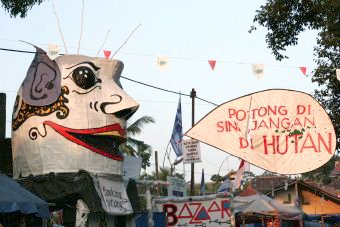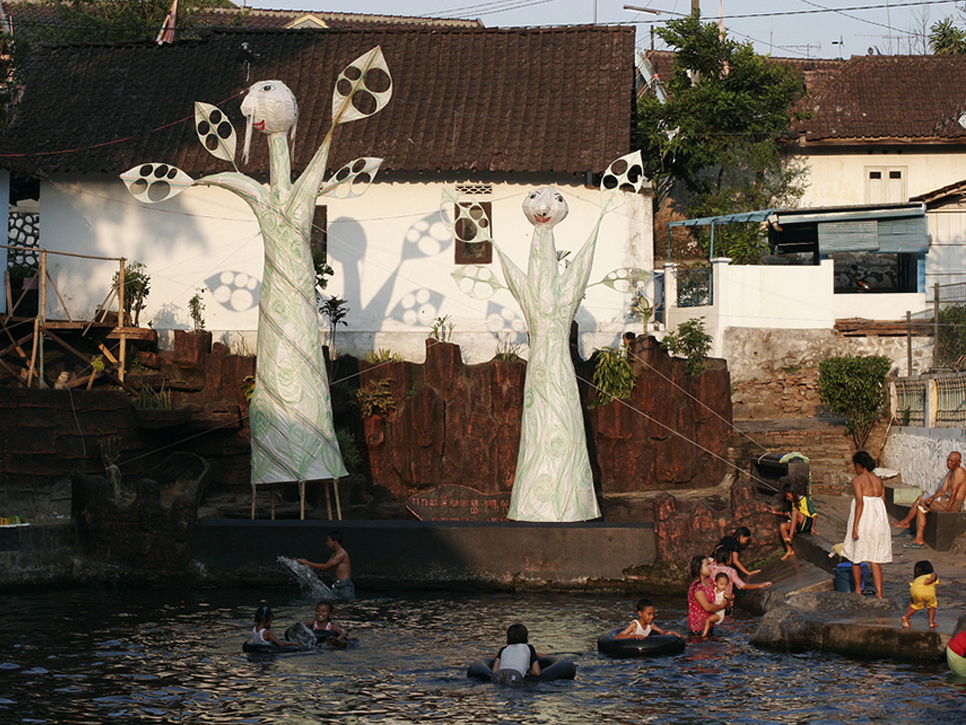A community takes a fresh look at water
Alexandra Crosby
 |
Kalitaman school kids made costumes out of household rubbish for an opening parade. |
The climate of greater political and social freedom in Indonesia over the last decade has prompted the formation of a number of collectives, such as Taring Padi and RuangRupa, which use art to encourage social and environmental change. A recent trend has been innovative models of activism which culminate in local festivals.
Kalitaman is usually a modest, quiet urban kampung in the hilly city of Salatiga. It has a range of environmental challenges, including changes to its beautiful mata air (natural water springs). Demands on water supplies from the textile industry and the increasingly urbanised population have led to many of the springs drying up. Also, the erosion caused by the felling of forests in the surrounding area, combined with layers of non-biodegradable plastic rubbish dumped in the springs, prevents their rejuvenation. Erosion increases the level of run-off in the wet season, increasing the risk of flooding. In the dry season, the erosion reduces the base flow of rivers which affects both water quality and groundwater levels for domestic drinking water.
Celebrating water
In September 2007, artists and activists collaborated with local residents to draw attention to the state of the local water supply. They organised the second Festival Mata Air (Festival of Water), a celebration of sustainability through creative production.
 |
Australian artist Kath Ellis collaborated with Salatiga artists to build huge bamboo lanterns at the baths |
The event was organised by TUK (Planting for Life), a group of local artworkers which emerged in the Salatiga area in 2005. Part of a new generation of artists frustrated by the lack of exhibition, study, and work prospects, several of TUK’s most active members are also ‘craftspeople’ who do not have a formal education in art. Instead, they have earned their livings carving or painting intricate designs into wood furniture or houses.
TUK members were inspired by environmental activists in other areas of Java, such as those who organise the Forest Art Festival in Blora. They were keen to adapt a festival model to address their own ecological problems. The first Festival Mata Air was held in November 2006 at Senjoyo, a natural spring about 15 kilometers from the centre of Salatiga. During the 12 months preceding the festival, TUK organised a number of programs to clean up the site, raise awareness about waste and pollution, and create a dialogue between the government, industry and the community. All this work culminated in a three-day art and music festival.
‘After something spectacular like this, which combines activism with having a great time, it is about harnessing momentum.'
‘Senjoyo was great,’ says Rudy Ardianto, one of TUK’s organisers, ‘but for 2007, we wanted to focus on a kampung in the city, so we approached the Kalitaman community. We knew that there would be a more intense relationship between the artists and the neighbourhood, that we could involve more people, and that the events would be easier to get to.’ The festival certainly attracted huge audiences. With over 1000 people swarming in to enjoy the outdoor concerts, local vendors couldn’t keep up with the demand for satay and roast corn.
There was a market, children’s art activities, community forums, an exhibition of environmental art, large-scale installations (all made from garbage), workshops on reuse of packaging and other post-consumer waste, recycling, composting and do-it-yourself printing. But the main focus of the festival was water.
 |
Street side barber: ‘Chop here, not in the forest.’ |
Performers included Sawung Jabo, Kath Ellis, Anti-Acne, and Sound Rebel, as well as a host of other performers who came from across the Indonesian archipelago and from abroad. As well as being motivated by the urgency of the issues of water in Indonesia, including ownership, contamination, and scarcity, they were drawn by the opportunity to work directly with a community which is taking the health of its environment into its own hands.
‘It was important that this happened in the middle of the dry season,’ says Rudy. ‘People think more about water when it is scarcer. It reminds us how precious and important it is as a resource and part of community culture. Kalitaman residents have a history of protecting their water sources. When an outside company tried to take over in the 90s, the kampung fought back. They know that this is an important issue and that is why we are all so keen to work together.’
Change through revelry
One of Kalitaman’s springs, traditionally used as a public bath for men, has already dried up. Now, the remaining spring is used by men, women and children for bathing, laundry, washing, and playing. TUK doesn’t claim to ‘solve’ anything but it works with a range of local and national organisations, such as Plan-Grombongan, PUSDAKOTA-Surabaya (Centre for the Empowerment of Urban Communities), as well as local government and industry, to encourage real grassroots change. And the Kalitaman community is organising economically viable cooperatives for composting, planting, and waste reduction. ‘This always has to be an ongoing movement,’ says Rudy. ‘After something spectacular like this, which combines activism with having a great time, it is about harnessing momentum.’
TUK describes its own practice as art that ‘sidesteps artists’ egos’ through a collective process of design and implementation. This was evident in the complete transformation of Kalitaman into a hub of site-specific performance, art installation, and knowledge exchange. Through revelry, a small community gave form to the colourful, creative, world of environment art they had collectively imagined. ii
Alexandra Crosby (ali@alimander.com ) is an artist, writer and researcher. She is currently completing a Masters degree at the University of Technology Sydney, on the visual culture of activists in Java. She is also director of Gang, a festival of creative exchange between artists in Australia and Indonesia: http:www.gangfestival.com . See more of her photos on the Festival Mata Air at http://www.flickr.com/photos/alimander/sets/72157601983169722/ Research for this article was supported by the Australian Research Council.












